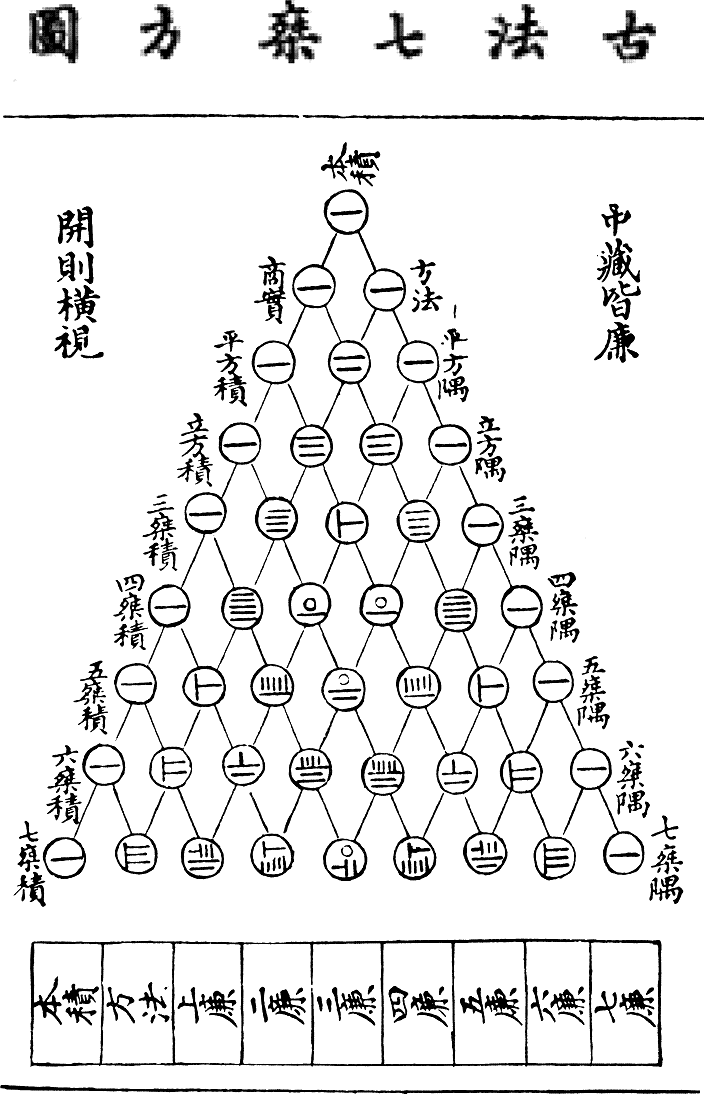The Chinese History of Pascal's Triangle
The fascinating Pascal Triangle follows a triangular array of numbers that presents us with the coefficients in order to expand, and even solve for any binomial expression raised to any power. While Blaise Pascal was one of the
first to discover many of the interesting properties and present the idea on a wider scale, he was not the first to discover the
actual triangle. The first people to discover the triangle were the Chinese.
As early as the 10th century, Chinese mathematician, Jia Xian, formed a basis on a triangular diagram that still grasps the same concepts and ideas as we see it today!

This was Jia Xian's presentation of his triangle created. The dashes and lines shown above are "rods" that were actually used in early Chinese mathematics. The Chinese Rod system was actually used for doing arithmetic rather than writing and recording. As you can see from Jia Xian's triangle above, the system stays more or less the same.
The first column has the Chinese character:
"1"
Followed by "1-1"
Followed by "1-3-3-1" and so on.
An idea to note, the pronunciation in Chinese for the coefficients of Pascal's Triangle is completely different to what's written above. If you see the character for (一 一) or "11", the actual word in Chinese for 11 is (十一), which literally translates to "ten-one". I'm not quite sure if ancient Chinese mathematicians would directly read from the graph of (1-1) or the actual word for 11. Just a thought...
Later in the 13th century, another Chinese mathematician, Yang Hui built the formal version of Pascal's Triangle and how we see it today. The "ancient rods" are gone and have been simplified to standard Chinese characters that would directly translate into numbers like today's Pascal's Triangle.

As early as the 10th century, Chinese mathematician, Jia Xian, formed a basis on a triangular diagram that still grasps the same concepts and ideas as we see it today!

This was Jia Xian's presentation of his triangle created. The dashes and lines shown above are "rods" that were actually used in early Chinese mathematics. The Chinese Rod system was actually used for doing arithmetic rather than writing and recording. As you can see from Jia Xian's triangle above, the system stays more or less the same.
The first column has the Chinese character:
"1"
Followed by "1-1"
Followed by "1-3-3-1" and so on.
An idea to note, the pronunciation in Chinese for the coefficients of Pascal's Triangle is completely different to what's written above. If you see the character for (一 一) or "11", the actual word in Chinese for 11 is (十一), which literally translates to "ten-one". I'm not quite sure if ancient Chinese mathematicians would directly read from the graph of (1-1) or the actual word for 11. Just a thought...
Later in the 13th century, another Chinese mathematician, Yang Hui built the formal version of Pascal's Triangle and how we see it today. The "ancient rods" are gone and have been simplified to standard Chinese characters that would directly translate into numbers like today's Pascal's Triangle.

https://cdn.britannica.com/s:300x300/03/59803-004-88609FEC.jpg

Comments
Post a Comment